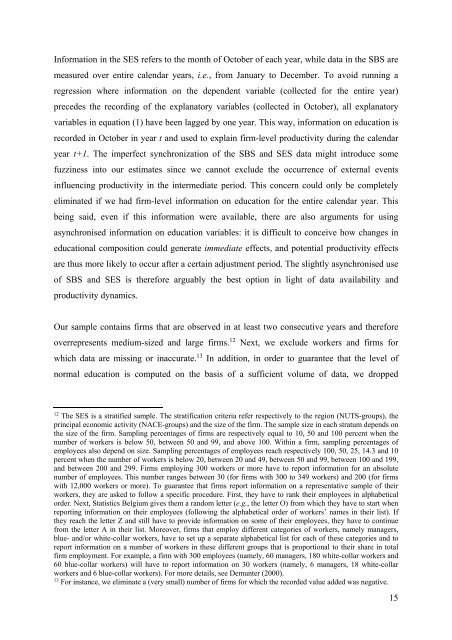CEB Working Paper
240798&r=lma
240798&r=lma
Create successful ePaper yourself
Turn your PDF publications into a flip-book with our unique Google optimized e-Paper software.
Information in the SES refers to the month of October of each year, while data in the SBS are<br />
measured over entire calendar years, i.e., from January to December. To avoid running a<br />
regression where information on the dependent variable (collected for the entire year)<br />
precedes the recording of the explanatory variables (collected in October), all explanatory<br />
variables in equation (1) have been lagged by one year. This way, information on education is<br />
recorded in October in year t and used to explain firm-level productivity during the calendar<br />
year t+1. The imperfect synchronization of the SBS and SES data might introduce some<br />
fuzziness into our estimates since we cannot exclude the occurrence of external events<br />
influencing productivity in the intermediate period. This concern could only be completely<br />
eliminated if we had firm-level information on education for the entire calendar year. This<br />
being said, even if this information were available, there are also arguments for using<br />
asynchronised information on education variables: it is difficult to conceive how changes in<br />
educational composition could generate immediate effects, and potential productivity effects<br />
are thus more likely to occur after a certain adjustment period. The slightly asynchronised use<br />
of SBS and SES is therefore arguably the best option in light of data availability and<br />
productivity dynamics.<br />
Our sample contains firms that are observed in at least two consecutive years and therefore<br />
overrepresents medium-sized and large firms. 12 Next, we exclude workers and firms for<br />
which data are missing or inaccurate. 13 In addition, in order to guarantee that the level of<br />
normal education is computed on the basis of a sufficient volume of data, we dropped<br />
12<br />
The SES is a stratified sample. The stratification criteria refer respectively to the region (NUTS-groups), the<br />
principal economic activity (NACE-groups) and the size of the firm. The sample size in each stratum depends on<br />
the size of the firm. Sampling percentages of firms are respectively equal to 10, 50 and 100 percent when the<br />
number of workers is below 50, between 50 and 99, and above 100. Within a firm, sampling percentages of<br />
employees also depend on size. Sampling percentages of employees reach respectively 100, 50, 25, 14.3 and 10<br />
percent when the number of workers is below 20, between 20 and 49, between 50 and 99, between 100 and 199,<br />
and between 200 and 299. Firms employing 300 workers or more have to report information for an absolute<br />
number of employees. This number ranges between 30 (for firms with 300 to 349 workers) and 200 (for firms<br />
with 12,000 workers or more). To guarantee that firms report information on a representative sample of their<br />
workers, they are asked to follow a specific procedure. First, they have to rank their employees in alphabetical<br />
order. Next, Statistics Belgium gives them a random letter (e.g., the letter O) from which they have to start when<br />
reporting information on their employees (following the alphabetical order of workers’ names in their list). If<br />
they reach the letter Z and still have to provide information on some of their employees, they have to continue<br />
from the letter A in their list. Moreover, firms that employ different categories of workers, namely managers,<br />
blue- and/or white-collar workers, have to set up a separate alphabetical list for each of these categories and to<br />
report information on a number of workers in these different groups that is proportional to their share in total<br />
firm employment. For example, a firm with 300 employees (namely, 60 managers, 180 white-collar workers and<br />
60 blue-collar workers) will have to report information on 30 workers (namely, 6 managers, 18 white-collar<br />
workers and 6 blue-collar workers). For more details, see Demunter (2000).<br />
13<br />
For instance, we eliminate a (very small) number of firms for which the recorded value added was negative.<br />
15


